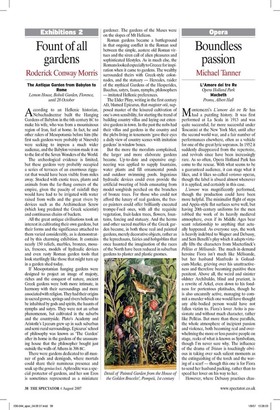Fount of all gardens
Roderick Conway Morris The Antique Garden from Babylon to Rome Lemon House, Boboli Garden, Florence, until 28 October According to an Hellenic historian, Nebuchadnezzar built the Hanging Gardens of Babylon in the 6th century BC to make his wife, who was from a mountainous region of Iran, feel at home. In fact, he and other rulers of Mesopotamia before him (the first such gardens were probably at Nineveh) were seeking to impress a much wider audience, and the Babylon version made it on to the list of the Seven Wonders of the World.
The archeological evidence is limited, but these gardens very probably occupied a series of terraces of an enormous ziggurat that would have been visible from miles away. Stocked with exotic trees, plants and animals from the far-flung corners of the empire, given the paucity of rainfall they would have had to be irrigated with water raised from wells and the great rivers by devices such as the Archimedean Screw (which long predated the Greek scientist) and continuous chains of buckets.
All the great antique civilisations took an interest in cultivating their own gardens, but their forms and the significance attached to them varied considerably, as is demonstrated by this charming exhibition. It contains nearly 150 reliefs, marbles, bronzes, mosaics, frescoes, models of hydraulic devices and even rusty Roman garden tools that look startlingly like those that might turn up in a garden shed today.
If Mesopotamian hanging gardens were designed to project an image of majesty, riches and the conquest of nature, ancient Greek gardens were both more intimate, in harmony with their surroundings and more associated with religion. They had their origins in sacred groves, springs and rivers believed to be inhabited by gods and spirits, the haunts of nymphs and satyrs. They were not an urban phenomenon, but cultivated in the suburbs and the countryside. Plato's Academy and Aristotle's Lyceum grew up in such suburban and semi-rural surroundings. Epicurus' school of philosophy was known as 'The Garden' after its home in the gardens of the unassuming house that the philosopher bought just outside the walls of Athens in 306 BC.
There were gardens dedicated to all manner of gods and demigods, where mortals could share their numinous presence and soak up the genius loci. Aphrodite was a special protector of gardens, and her son Eros is sometimes represented as a miniature gardener. The gardens of the Muses were on the slopes of Mt Helicon.
Roman gardens became a battleground in that ongoing conflict in the Roman soul between the simple, austere old Roman virtues and the siren call of alien pleasures and sophisticated lifestyles. As in much else, the Romans looked especially to Greece for inspiration when it came to gardens. The wealthy surrounded theirs with Greek-style colonnades, and the statuary — Hercules, raider of the mythical Gardens of the Hesperides, Bacchus, satyrs, fauns, nymphs, philosophers — imitated Hellenic preferences.
The Elder Pliny, writing in the first century AD, blamed Epicurus, that magister otii, supposed master of the leisured cultivation of one's own sensibility, for starting the trend of building country villas and laying out extensive gardens in town. In the past the nobs had their villas and gardens in the country and the plebs living in tenements 'gave their eyes a daily view of country scenes with imitation gardens' in window boxes.
But the more the moralists complained, the larger and more elaborate gardens became. Up-to-date and expensive engineering was applied to supply fountains, water plants and fill ornamental ponds and outdoor swimming pools. Ingenious hydraulic devices could even provide the artificial tweeting of birds emanating from model songbirds perched on the branches of bronze trees. For those who could not afford the luxury of real gardens, the fresco painters could offer brilliantly executed trompe-l'oeil ones, with all the requisite vegetation, fruit-laden trees, flowers, fountains, fencing and statuary. And the herms and other sacred marbles of the Greek garden became, in both these real and painted gardens, merely decorative objects, rather as the leprechauns, fairies and hobgoblins that once haunted the imagination of the races of the North have been reduced in suburban gardens to plaster and plastic gnomes.








































 Previous page
Previous page